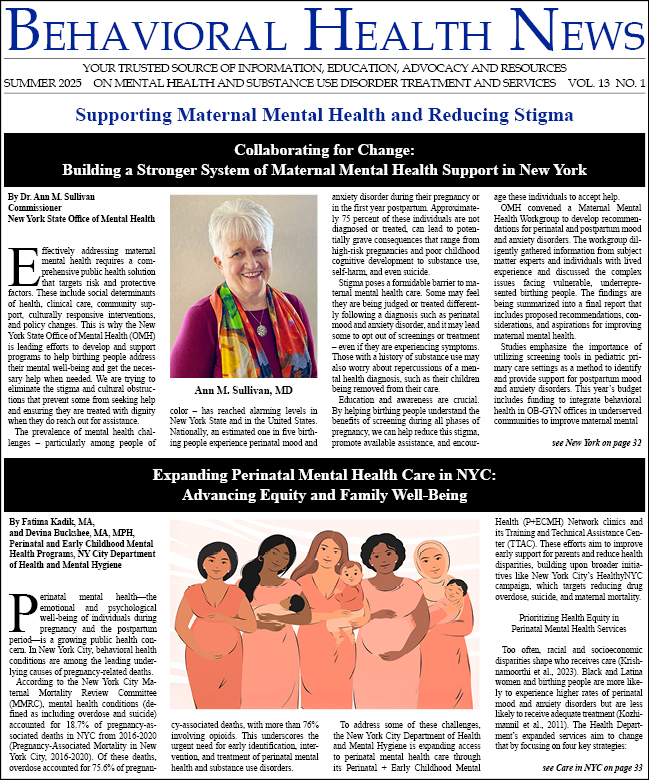As a psychiatrist and parent of two teenage boys, youth health and wellbeing are critically important to me, both professionally and personally.

I am deeply concerned about the increasing prevalence and complexity of co-occurring disorders in youth, where mental health disorders coexist with substance use disorders (SUD), underscoring the critical need for more effective interventions and treatment strategies.1 We are seeing a rising incidence of youth suicide and overdose deaths—these primarily driven by opioids—all exacerbated by the COVID-19 pandemic, the impact of social media (bullying and body image issues), stigma, and inadequate access to specialized services and treatment options.
Research has shown that adolescence is a vulnerable period for the onset of mental health and substance use disorder, with significant correlation and influence between poor mental health, suicidality, and substance misuse/use among youth.2 For example, adolescents may use substances as a maladaptive way to cope with the symptoms of a mental health disorder, only to find that the substance misuse/use amplifies their emotional and psychological challenges. In adolescents, these risks can disrupt social and developmental progress (young people are still developing critical coping and decision-making skills), at times leading to poor academic performance, strained family relationships, and increased social isolation. Ultimately, these are impacted by the challenges in accessing effective treatment—in 2023, only 1 in 5 adolescents with a substance use disorder received treatment for their condition in the past year.3
Additionally, the overdose epidemic has deeply affected adolescents, often within their own homes—a recent study showed that more than 321,000 US children lost a parent to drug overdose between 2011 and 2021.4 Additionally, Substance Abuse and Mental Health Services Administration (SAMHSA) estimates that 1 in 8 children aged 17 or younger live with at least one parent with an SUD.5 These conditions potentially increase the risk for abuse, neglect, mental health conditions, and substance use disorders.6 Despite these serious impacts, we still don’t have a robust body of adolescent-specific research, which hampers the development of effective interventions aimed at adolescents at risk.7
The 2023 Youth Risk Behavior Survey8 among US high school students highlights several concerning trends9:
- 40% persistent feelings of sadness or hopelessness in the past year.
- 20% seriously considering attempting suicide in the past year.
- 16% making a suicide plan in the past year.
- 9% attempting suicide in the past year.
- 22% drinking alcohol in the past 30 days.
- 17% using marijuana in the past 30 days.
- 4% misusing prescription pain medication in the past 30 days.
- 10% ever using illicit drugs.
Many of these issues are influenced by external factors, systemic inequities, and barriers, with stark differences in suicide and substance use disorder rates among youth across various demographic variations based on race, ethnicity, gender, sexual orientation, and geography.
Suicide rates and drug overdose deaths remain disproportionately high among non-Hispanic American Indian and Alaska Native youths10, and many of the factors contributing to these high rates include systemic poverty, limited access to mental and SUD care, and significant historical trauma.11 Recent studies have shown a worrying increase in suicide rates among Black children and teenagers, significantly outpacing other groups.12 Additionally, boys are particularly at risk, constituting nearly 80% of suicide cases13 and more than two-thirds of overdose deaths—90% of those deaths involved opioids, 84% involved illicitly manufactured fentanyl (IMF), and 25% involved counterfeit pills.14 LGBTQ+ youth are at high risk, reporting significantly higher rates of sadness, hopelessness, suicidal behavior, and SUD compared to their heterosexual peers. Homophobia, bullying, and a lack of social support are significant factors that contribute to higher stress levels and mental health challenges.15 LGBTQ+ youth are more likely to experience substance use as a coping mechanism for emotional and psychological distress.16
Socioeconomic factors and accessibility to behavioral health supports and services play a critical role in influencing outcomes among youth. Economic instability, lack of health insurance, and living in under-resourced communities influence the rates of suicide and substance use among youth; for example, lower socioeconomic status is often correlated with higher exposure to various risk factors for behavioral health conditions, including food insecurity, exposure to violence, familial instability, limited access to educational or employment opportunities.
There is often a significant disparity in the availability and accessibility of mental health and/or substance use services between urban and rural areas, with rural areas typically having fewer resources. This geographical disparity can delay the diagnosis and treatment of mental health and substance use disorders, allowing them to progress to more severe states.
Adolescents also face numerous barriers to accessing effective treatment for SUDs17, including a lack of youth-focused SUD programming—typically abstinence-based with high rates of dropout18, and limited availability to specialized residential treatment facilities, all too often with long wait lists and high costs.19 Additionally, medications like buprenorphine are FDA-approved for 16 and older, and very few adolescents receive this medication. The majority of residential settings do not prescribe it to adolescents.20
Youth without health insurance or with inadequate coverage have a much harder time accessing or affording behavioral health services, which delays them from receiving timely and effective treatment for their mental health issues and SUDs. Accessibility is not just about physical availability but also about the relevance and sensitivity of the services provided. There is a need for culturally competent care that takes into account the cultural, social, and linguistic needs of diverse populations, and the lack of such tailored care can discourage youth from seeking help or adhering to treatment plans.
In many communities, especially in lower SES or certain cultural groups, there is a significant stigma associated with mental illness and substance use, which we know prevents young people from seeking help due to fear of discrimination or misunderstanding from their family and peers. A recent study21 focused on adolescent perspectives on the facilitators, barriers, and preferences for health services, specifically in addressing opioid use disorder (OUD). Key barriers included stigma, lack of motivation, and external influences from peers. Facilitators were supportive environments and accessible health services, underscoring the need for more effective health services that align with the preferences and actual environments of the youth.
These disparities and barriers call out the critical need for continued efforts in addressing behavioral health issues among youth and highlight the need for targeted interventions and policy adjustments to address the specific needs of our youth. Understanding the complex interplay between mental health disorders, substance use, suicidal ideation, and overdose risks is crucial in developing effective prevention and intervention strategies that can save lives.
Effective interventions require integrated treatment approaches that address both mental health and substance use simultaneously to improve outcomes22. Ongoing prevention efforts must be focused on enhancing behavioral health support, reducing access to means of suicide, overdose safety planning, and promoting social connectivity and resilience among youth.
Addressing the rising trends of mental health issues and substance use disorders among youth, with an emphasis on decreasing the rates of suicide and overdose, requires coordinated efforts from policymakers, educational institutions, communities, and the healthcare system.
Here are some recommendations that can start to make an impact on the dual crisis of youth suicide and substance use disorders:
Policymakers
- Enhance Funding for Mental Health Services: Increase allocation of federal and state funds to expand mental health and SUD supports, services, and treatment options, especially in underserved areas and to at-risk groups.
- Support School-Based Health Programs: Legislate for the integration of comprehensive behavioral health services in schools, including funding for school counselors and access to emergency behavioral health interventions.
- Enforce and Expand Mental Health Parity: Ensure that mental health and physical health are treated equally in insurance coverage and rigorously enforce existing mental health parity laws to reduce disparities in treatment access.
- Promote Early Intervention Programs: Invest in early screening and intervention programs within schools and community centers to identify mental health and SUD issues before they escalate.
Educational Institutions
- Implement Comprehensive School Behavioral Health Systems: Develop and implement an integrated system that includes training for teachers on the signs of mental health issues and SUD, alongside providing in-school counseling services.
Organizations like the School-Based Health Alliance work to integrate mental health services directly into schools, where mental health professionals provide counseling, crisis intervention, and ongoing support directly on campus. This not only reduces stigma associated with seeking help but also increases accessibility for students who might not have reliable transportation or parental support for off-campus appointments.
- Curriculum Integration: Include wellbeing and behavioral health education within the school curriculum to raise awareness, reduce stigma, and promote health-seeking behavior among students.
- Crisis Management Protocols: Establish clear protocols for handling behavioral health crises, including the availability of behavioral health professionals and clear pathways for immediate intervention and support.
- Peer Support Programs: Facilitate peer mentoring and support programs that train students to recognize signs of mental distress among their peers and provide initial support or referral to professional help.
Youth MOVE National advocates for peer support roles within mental health and substance use treatment settings. These programs train young people who have lived experience with mental health conditions or recovery from substance use to provide support, mentorship, and guidance to their peers, which can be particularly empowering and effective in promoting recovery and resilience.
Communities
- Community-Based Outreach Programs: Launch community outreach programs aimed at educating parents and youth about mental health and SUD issues—like Mental Health First Aid—focusing on early signs, prevention strategies, and available treatment options.
- Access to Community Centers: Support the creation or enhancement of community centers that provide free or low-cost behavioral health services and act as safe spaces for young people to seek help.
- Partnerships Between Community Groups and Health Providers: Foster collaborations between schools, local health services, and community organizations to create a cohesive support system that addresses the broad spectrum of youth needs.
- Cultural Competence: Encourage community programs to incorporate culturally competent practices that respect and understand the diverse backgrounds of community members to ensure effective communication and intervention strategies.
Many communities have developed outreach programs that focus on educating youth about the risks associated with substance use, as well as strategies for emotional regulation and coping with stress. Programs such as the Community Anti-Drug Coalitions of America (CADCA) train youth leaders to conduct peer education sessions, enhancing community resilience and knowledge about substance abuse prevention.
Healthcare System
- Promote Interdisciplinary Collaboration: Encourage cooperation among psychiatrists, psychologists, social workers, and pediatric providers to ensure a holistic approach to mental health care. Integrated care models that encompass physical and behavioral health lead to better patient outcomes23
- Implement Routine Screening: Incorporate routine mental health and substance use screenings during medical visits for all youth. Early detection of mental health issues and substance use disorders can significantly improve the effectiveness of interventions. Early and universal screening for suicide and overdose risk, using tools like the Columbia-Suicide Severity Rating Scale (C-SSRS) and Zero Overdose (ZO) OD Safety Planning, is crucial. These can identify at-risk individuals promptly, allowing for timely interventions that can save lives and significantly reduce the incidence of suicide and overdose events among youth.
- Enhance Training: Provide ongoing education and training for all healthcare providers on the latest treatments and interventions for mental health and substance use disorders. Special focus should be on emerging trends and evidence-based practices, especially focused on adolescents.
- Community-Based Initiatives: Engage with and support community programs that work toward preventing mental health issues and substance use disorders in youth. This can include participating in outreach efforts, providing expert advice, and facilitating workshops or seminars.
- Leverage Technology for Better Reach: Utilize telemedicine and online technology-assisted care solutions to reach young people who may not have easy access to traditional healthcare settings. This is especially important in rural or underserved areas and among marginalized groups.
There are a growing number of apps and online platforms that offer tailored mental health resources and connect young people with therapists via text, call, or video. These tools are designed to meet youth where they are—online—and provide confidential and immediate support for those who might be reluctant to seek face-to-face counseling. In NYC, the Department of Health and Mental Hygiene partnered with Talkspace to offer free mental health support program available to any teenager age 13 to 17.
As we confront the escalating trends of mental health issues and substance use disorders among youth, the need for a concerted, collaborative effort becomes ever more apparent. The healthcare system, policymakers, educational institutions, and communities must unite to expand and enhance behavioral health resources.
It is crucial that we continue to innovate and invest in comprehensive strategies that include early intervention, integrated school-based health programs, and community outreach that is culturally competent and accessible to all. Only through sustained commitment and proactive engagement can we hope to stem the tide of rising mental health and substance use challenges facing our youth today.
Together, we can build a foundation for a healthier future for our children, prioritizing well-being as part of our collective commitment to nurturing resilient and thriving homes and communities.
Jorge R. Petit, MD, is a Behavioral Healthcare Leader, Author, and Founder/CEO of Quality Healthcare Solutions, LLC. Dr. Petit is also a long-time Board Member and past Chair of Mental Health News Education, the publisher of Autism Spectrum News and Behavioral Health News. For more information, visit his website: www.drjpetit.org, blog: Behavioral Health: Matters, LinkedIn: Dr. Jorge Petit, MD, or Substack: drjrpetit.substack.com.
Footnotes
- https://pmc.ncbi.nlm.nih.gov/articles/PMC9955022/pdf/children-10-00293.pdf
- https://journals.plos.org/plosone/article?id=10.1371/journal.pone.0255799 https://www.samhsa.gov/data/sites/default/files/reports/rpt47095/National%20Report/National%20Report/2023-nsduh-annual-national.pdf
- Jones CM, Zhang K, Han B, et al. Estimated Number of Children Who Lost a Parent to Drug Overdose in the US From 2011 to 2021. JAMA Psychiatry. 2024;81(8):789–796. https://doi:10.1001/jamapsychiatry.2024.0810
- https://www.samhsa.gov/data/sites/default/files/report_3223/ShortReport-3223.pdf
- https://www.clinicaltherapeutics.com/action/showPdf?pii=S0149-2918%2819%2930308-X
- https://oneill.law.georgetown.edu/addressing-the-opioid-epidemic-among-adolescents-in-the-united-states/
- Centers for Disease Control and Prevention. (2024). Youth Risk Behavior Survey Data Summary & Trends Report: 2013–2023. Retrieved from https://www.cdc.gov/yrbs/dstr/.
- https://www.cdc.gov/suicide/facts/data.html
- https://www.cdc.gov/nchs/products/databriefs/db522.htm
- https://www.cdc.gov/suicide/facts/data.html
- Sheftall AH, Vakil F, Ruch DA, Boyd RC, Lindsey MA, Bridge JA. Black youth suicide: Investigation of current trends and precipitating circumstances. Journal of the American Academy of Child and Adolescent Psychiatry. 2022;61(5):662-675. https://dx.doi.org/10.1016/j
- https://pmc.ncbi.nlm.nih.gov/articles/PMC9437900/pdf/nihms-1832384.pdf
- https://www.cdc.gov/mmwr/volumes/71/wr/mm7150a2.htm
- https://www.cdc.gov/yrbs/dstr/index.html
- https://www.cdc.gov/mmwr/volumes/73/su/su7304a9.htm
- https://www.kff.org/mental-health/issue-brief/teens-drugs-and-overdose-contrasting-pre-pandemic-and-current-trends/
- https://oneill.law.georgetown.edu/addressing-the-opioid-epidemic-among-adolescents-in-the-united-states/
- https://nida.nih.gov/news-events/news-releases/2024/01/residential-addiction-treatment-for-adolescents-is-scarce-and-expensive
- https://pmc.ncbi.nlm.nih.gov/articles/PMC6003902/
- https://www.jahonline.org/article/S1054-139X(24)00691-8/pdf
- https://srrjournals.com/ijsrmd/sites/default/files/IJSRMD-2024-0032.pdf
- https://bipartisanpolicy.org/youth-mental-health-and-substance-use-task-force/






